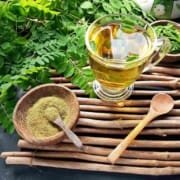Dragon Fruit Benefits: 8 Science-Backed Health Advantage
Dragon fruit, with its vibrant colors and unique appearance, isn’t just a visual delight, it’s also packed with nutrients that offer impressive health benefits. From boosting immunity to aiding digestion, this tropical fruit is worth adding to your diet. Let’s explore what makes dragon fruit so special.
What Is Dragon Fruit?
Dragon fruit grows on the dragon fruit cactus, scientifically known as Hylocereus. The name comes from Greek and Latin roots, “hyle” (woody) and “cereus” (waxen)—referring to the plant’s sturdy, vine-like structure. Originally from Mexico and Central and South America, the French introduced it to Southeast Asia in the 1800s. Today, the U.S. imports dragon fruit, though some farms in Florida, California, and Hawaii grow it domestically.
This exotic fruit has a striking look: a bright pink or yellow dragon fruit exterior with green, flame-like scales. Inside, its flesh can be white, pink, red, or purple, speckled with tiny black seeds—similar to a kiwi. Depending on where you are, it goes by different names, such as pitaya in Central America or strawberry pear in parts of Asia.
What Does Dragon Fruit Taste Like?
If you’re wondering, “What does dragon fruit taste like?”, the answer is mildly sweet and refreshing. Its flavor is often compared to a mix of kiwi, pear, and watermelon, with a slight nuttiness from the edible seeds.
Different Types of Dragon Fruit
Dragon fruit comes in several varieties, each with distinct colors and flavors:
- White Dragon Fruit – The most common type, with pink skin and white flesh. It’s less sweet than other varieties and often sold under names like Alice or Cosmic Charlie. Vietnam is a major producer.
- Red Dragon Fruit – Features pink or red skin with deep red flesh. Sweeter than white varieties, popular types include Red Jaina and Bloody Mary, primarily grown in Nicaragua and Ecuador.
- Yellow Dragon Fruit – Recognizable by its bright yellow skin and white interior, this type is the sweetest but less commonly found. It’s mostly imported from Ecuador and other Central/South American regions.
- Other Varieties – Some hybrids, like American Beauty, have pink skin and purple flesh. These are grown in places like Florida and California, originally from Guatemala.
Dragon Fruit Nutrition Facts
One cup of dragon fruit cubes provides:
- Calories: 103
- Fat: 0.2g
- Protein: 0.6g
- Carbohydrates: 27g
- Fiber: 6g (21% of daily value)
- Sugars: 18g
It’s also rich in essential vitamins and minerals, including:
- Vitamin C: 8mg (9% DV)
- Calcium: 16mg
- Iron: 0.3mg
- Magnesium: 13mg
With its low calorie count and high fiber content, dragon fruit is a great addition to a balanced diet. But its real power lies in its health benefits—which we’ll explore next.
Top Health Benefits of Dragon Fruit
Dragon fruit isn’t just visually striking—it’s packed with nutrients that offer a wide range of potential health benefits. While research is still evolving, studies suggest this tropical fruit may support everything from digestion to immune function. Here’s a closer look at the science-backed benefits of dragon fruit.
1. Rich in Powerful Antioxidants
One of the standout dragon fruit benefits is its high antioxidant content. Antioxidants help neutralize harmful free radicals—unstable molecules linked to chronic diseases and premature aging. Dragon fruit contains several key antioxidants:
- Betalains (found in red dragon fruit): These pigments may help lower LDL (“bad”) cholesterol and reduce heart disease risk factors.
- Hydroxycinnamates: Early lab studies suggest these compounds may have anticancer properties.
- Flavonoids: Linked to improved brain health and reduced risk of heart disease.
While dragon fruit isn’t the most antioxidant-rich fruit overall, research shows it’s particularly effective at protecting fatty acids from oxidative damage.
2. Supports Digestive Health
Wondering “what is dragon fruit good for” when it comes to digestion? A single cup provides 6 grams of fiber (21% of your daily needs), offering two key benefits:
- Relieves constipation: The fiber adds bulk to stool and acts as a mild natural laxative.
- Feeds gut bacteria: Dragon fruit contains prebiotics that nourish beneficial probiotics like lactobacilli and bifidobacteria, promoting a healthy gut microbiome.
3. May Help Manage Blood Sugar
Emerging research suggests compounds in dragon fruit might help regulate blood sugar by:
- Supporting pancreas cell regeneration (where insulin is produced)
- Providing fiber that slows sugar absorption
While animal studies show promise, human research—particularly in diabetics—remains limited.
4. Boosts Immune Function
The combination of nutrients in dragon fruit makes it excellent for immunity:
- Vitamin C (9% DV per cup): Supports white blood cell function and acts as an antioxidant.
- Prebiotics: A healthy gut microbiome is crucial for immune defense.
5. May Reduce Inflammation
Lab studies indicate that both the pulp and peel of dragon fruit cactus contain anti-inflammatory compounds. Chronic inflammation is tied to numerous diseases, making this a potentially significant benefit.
6. Enhances Iron Absorption
While dragon fruit itself provides modest iron (0.3mg per cup), its high vitamin C content significantly improves your body’s ability to absorb iron from other foods—important for preventing anemia and maintaining energy levels.
7. Promotes Skin Health
The benefits of dragon fruit extend to your skin thanks to:
- Collagen production: Vitamin C is essential for making this skin-firming protein.
- Wound healing: The nutrient supports skin repair.
- Potential sun protection: Antioxidants may help combat UV damage, though more human studies are needed.
8. Supports Weight Management
At just 103 calories per cup with 6g of fiber, dragon fruit is an excellent weight-friendly snack. The fiber and water content promote satiety, helping you feel full longer between meals.
Note: While these dragon fruit benefits are promising, many studies are preliminary. More human research is needed to confirm some effects.
Dragon Fruit Juice: Is It Worth It?
While most research focuses on whole dragon fruit, some animal studies have examined the potential benefits of its juice or extracts. These studies suggest that concentrated forms may offer antioxidant benefits. However, there are important differences to consider:
- Store-bought juices often mix dragon fruit with other juices and added sugars, reducing its nutritional value.
- Homemade or 100% juices retain more nutrients but still lack the fiber of whole fruit, which helps regulate blood sugar.
Nutrition experts generally recommend eating whole dragon fruit to get the full benefits of dragon fruit, including its valuable fiber content.
Potential Side Effects of Dragon Fruit
For most people, dragon fruit is safe to enjoy with minimal risks. However, there are a few things to keep in mind:
- Allergic reactions are rare but possible, with symptoms like tongue swelling, hives, or vomiting.
- Red urine may occur after eating large amounts of red dragon fruit (similar to the effect of beets) – this is harmless and temporary.
- Digestive issues can happen if you consume too much fiber too quickly. Start with small portions if you’re not used to high-fiber foods.
How to Select and Prepare Dragon Fruit
Choosing the Best Fruit
Fresh dragon fruit is typically available June through September. Look for:
- Fruit that feels heavy for its size
- Smooth skin without bruises or shriveling
- Slight softness when gently pressed (indicates ripeness)
Frozen dragon fruit can be a convenient alternative, especially when fresh isn’t available. Choose options without added sugars for the healthiest choice.
How to Cut Dragon Fruit
Preparing dragon fruit is simple:
- Rinse the fruit under cool water
- Cut it in half lengthwise
- Scoop out the flesh with a spoon, or
- Peel the skin completely and slice the flesh
Creative Ways to Enjoy Dragon Fruit
Beyond eating it plain, there are many ways to incorporate dragon fruit into your diet:
- Fruit salads: Add colorful cubes for visual appeal
- Smoothies: Blend with other tropical fruits
- Salsas: Combine with lime, cilantro, and other fruits
- Desserts: Freeze puree for healthy popsicles
- Garnishes: Use thin slices to decorate dishes
The Bottom Line
Dragon fruit stands out among tropical fruits for its:
- Lower sugar content compared to many alternatives
- Impressive nutrient profile
- Unique appearance and mild flavor
While more human studies are needed to confirm all its potential dragon fruit benefits, it’s certainly a healthy, delicious way to add variety to your diet. Whether you enjoy it fresh, frozen, or in creative recipes, this exotic fruit is worth trying for both its taste and nutritional value.
Dragon Fruit FAQs
What does dragon fruit taste like?
Dragon fruit has a mildly sweet flavor often compared to a blend of kiwi, pear, and watermelon. The edible black seeds add a slight nutty crunch. Yellow varieties tend to be sweeter than pink-skinned ones.
Is dragon fruit good for weight loss?
Yes! With only 103 calories and 6g fiber per cup, dragon fruit helps promote fullness. Its low sugar content (compared to other tropical fruits) makes it a smart choice for weight management.
Can dogs eat dragon fruit?
In small amounts, yes. Dragon fruit is non-toxic to dogs and provides vitamins, but its high fiber may cause digestive upset if overfed. Always remove the skin and consult your vet first.
What’s the difference between red and yellow dragon fruit?
Red dragon fruit (pink skin/red or white flesh) is more common but less sweet. Yellow dragon fruit has brighter skin, white flesh, and the sweetest flavor. Both offer similar nutrients.
How do I know if a dragon fruit is ripe?
Ripe dragon fruit gives slightly when gently squeezed (like an avocado) and has vibrant, evenly colored skin without dark spots. Avoid rock-hard or shriveled fruits.
Does dragon fruit make you poop?
Thanks to its 6g fiber per cup, dragon fruit can help relieve constipation by adding bulk to stools. It acts as a gentle natural laxative for most people.
Is dragon fruit a cactus?
Yes! It grows on the Hylocereus cactus, also called the “dragon fruit cactus.” This climbing cactus thrives in tropical climates like Mexico and Southeast Asia.










